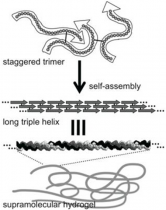Drug development based on collagen

- researcher's name
- affiliation
- research field
-
Structural biochemistry,Drug development chemistry,Biomolecular chemistry
- keyword
-
background
Collagen is a protein accounting for 30% of the total mass of our bodies, in bone, skin and more. As a matrix between cells, it has a range of functions in the body, such as tissue maintenance and cell differentiation. Based on an understanding of its structure and properties, triple-helical peptides that mimic collagen have been designed and synthesized, and efforts to create collagen-like peptides as candidates for drug discovery and cell-related experimental tools are being pursued with vigor.
summary
●Supramolecular materials having collagen-like triple-helical structure
●Library of collagen-like triple-helical peptides (approximately 800 types)
●Screening methods for collagen biological polymer bonding inhibitor compounds: (establishment of 384-well plate, high-throughput screening system)
application/development
●DDS, drug efficacy control: the collagen-like triple helix is resistant to most proteolytic enzymes. It may also have targeted functions based on collagen binding sites. It is thought that, by using these properties, it may be applied as a carrier, equipped with drug action, continuation time and targeting.
●Lead drug development compound: collagen-bound proteins are thought to be usable as treatment drugs for blood coagulation and cirrhosis of the liver.
●Experimental tools for cell culturing: by introducing specific sequences of collagen-like peptides as base materials for cell culturing, it will be possible to culture cells dependent on specific conditions.
predominance
We possess a system of research and development, based on collaboration both within and outside the school, through which mass analysis, animal experiments and other areas can be followed up.
Outcomes we have discovered include “drug development target HSP47 for fibrotic diseases (liver cirrhosis, scleroderma, etc.)”, “novel collagen-like substances with high biological stability”, “base material for culturing of fibroblasts reliant solely on integrin α2β1.”
purpose of providing seeds
Sponsord research, Collaboration research, Technical consultation
same researcher's seeds
posted:
2014/05/21




